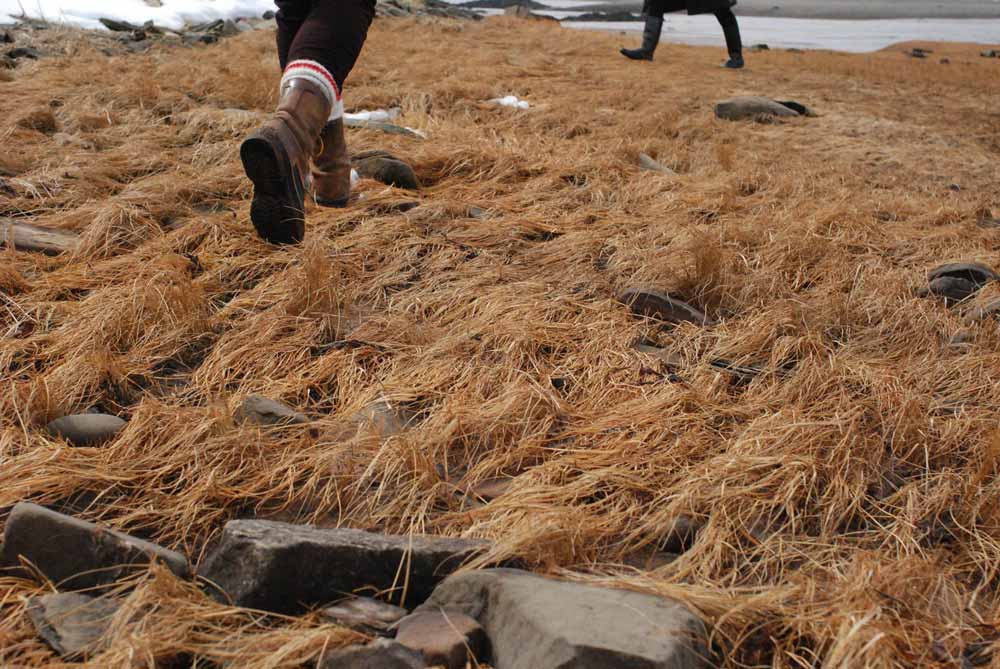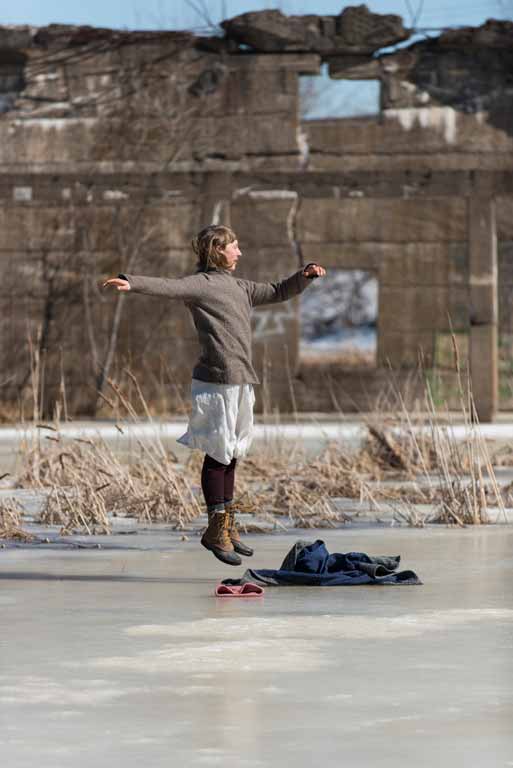Esemplastic Landing
2016—17
video: ︎Kingdom
video: ︎Kingdom
nomadic residency
After seven years of performing around the world, Lucy M. May returned to her Maritime homeland as an Artist-in-Residence. In and between New Brunswick’s southern towns and cities, Lucy moved through grass, mud, water, and wind for three months, across asphalt and train tracks. Her research aimed to develop a dance practice contiguous with the land and shared with the community.
Esemplastic Landing borrows the poet Coleridge’s word, meaning “molding into one.” As the flow of a river is inseparable from its banks, Lucy’s movements were both shaped by and carved into the Wolastoq River, the Petitcodiac watershed, the ubiquitous forest, intermittent outcrops of asphalt and marshland, and the Bay of Fundy.

Lucy M. May ©Mathieu Leger

Lucy M. May ©Mathieu Leger
performance practice
Seeking to strengthen her ties to New Brunswick and its communities, Lucy walked alone and with others through local landscapes, making ‘kinetic field recordings’ of the stories surfacing in bones, muscles, and organs, while traversing short and long distances. She then transmitted these records as improvised dances during free open-air performances:
We come about - knots of light and silence, Bridge Street, Sackville
Bridge Performance, Walking Bridge, Fredericton (St. John River Society)
From Very Far Away / De Très Très Loin, Old Arena, Moncton (Atlantic Ballet Theatre)
How Is It?, Swan Pond, Sackville (Mount Allison University Fine Arts Department)
What These Things Are Saying To Me, Purdy Crawford Centre, Sackville (Mount Allison U)
Grounded, Purdy Crawford Centre, Sackville (Mount Allison U)
The Lips of the River, Saint John Contemporary Dance Festival, Saint John (Connection Dance Works)


reflections
“I would like to acknowledge that this project takes place on the very beautiful traditional and unceded lands of the Wolastoqiyik, Mi’kmaq, and Peskotomuhkati of the Waban-aki Confederacy. I acknowledge that my lineage ties me to the industries of a Euro-descendant settler culture (pulp and paper, commercial agriculture, institutionalized arts and sciences), as a first generation New Brunswicker and a seventh generation Canadian.
[My] people and our way of life have divided and itemized a wholeness into finite parcels of property. We have transformed the animate landscape and more-than-human communities into a collection of objects. I acknowledge that the steps I take here won’t remove me from this earth or undo what has been done, so I walk here to discover in my body the relationship between my colonial heritage and the possibility of decolonization. I dance to imagine these apparently political notions as states of being, as ways of moving through the world. I recognize imperial patterns written into my very gestures, and imagine how decolonization might dance.
As I move, I try to engage in the work of “coming to our senses,” as writes David Abram in The Spell of the Sensuous. I am reminded of human fallibility and my own smallness. I recall the essential nature of community, both human and more-than-human. As I dance, I try to remember my place again in the rhythmic cycles of the living world, but also to situate my relationship to the communities who were here long before mine. May these dances be in dialogue with them, and may they be in service of restoring these lands to what they once were, and to what they can still become.
— Lucy M. May, Fredericton, Jul 9, 2017
quote
"Lucy danced, birds calling, tiger lilies, bergamot and a towering willow in the background. Spellbinding. After she finished, she asked me to dance. It was a magical experience.” Telegraph Journal (New Brunswick)
credits
partners Atlantic Ballet of Canada, Mount Allison University Fine Arts Department / Thaddeus Holownia, The St. John River Society
supporter Conseil des arts et des lettres du Québec
"Lucy danced, birds calling, tiger lilies, bergamot and a towering willow in the background. Spellbinding. After she finished, she asked me to dance. It was a magical experience.” Telegraph Journal (New Brunswick)
credits
partners Atlantic Ballet of Canada, Mount Allison University Fine Arts Department / Thaddeus Holownia, The St. John River Society
supporter Conseil des arts et des lettres du Québec
We would like to express our respect and gratitude to the traditional stewards of the stolen lands upon which these works were created: the Anishinaabeg, Chippewa, Haudenosaunee, Kanien’kehá:ka, Mi’kmaq, Mississaugas of the Credit, Peskotomuhkati, Sámi, Wabanaki, and Wolastoqey Nations and Confederacies. Creating dance and art relies on funding and resources, and all wealth comes from the earth. Land back.